Tom Morey: inventor of the Boogie Board wanted everyone to experience the ocean

Tom Morey, who over the summer celebrated the 50th anniversary of his most beloved invention, the Boogie Board, picked up a lot of descriptors to go after his name in his lifetime.
Tom Morey, innovator. Tom Morey, surf legend. “The Ben Franklin of the surfing world.” Jazz musician. Aeronautical engineer. “The most significant person to get people in the water.”
But Morey, who died on 14 October at the age of 86 from complications of a stroke, saw his role in life a little simpler than that.
“I would always hear my dad use these metaphors,” said his eldest son, Sol Morey. “One of his favorites was that all of us are on an airplane and he would say luckily he was able to get a window seat so he was able to share his vision of where we were going.”
Morey was born in Detroit but moved as a child to southern California. “As soon as he saw that blue ocean, he was in love,” said his son, talking to the Guardian by telephone. He began surfing in his teens, falling in with the “Endless Summer” crowd at the time and eventually earning enough renown to be featured on the cover of Surfer magazine.
An inventor since childhood, Morey constantly tinkered with the design of his surfboards to get the most out of their performance. Before he graduated from the University of Southern California with a degree in mathematics, he had created a honeycomb surfboard.
He would later create so much more, in the world of surfing and beyond. “He invented the ‘wing tip’, a Coaund Lift nose, and created the first polypropylene fin and first commercial interchangeable fin system,” surf historian Jim Kempton said. “His Morey-Pope shapes are sought-after boards to this day.”
After a stint as an engineer at Douglas Aircraft, Morey opened a surf shop and then launched the Invitational Nose Riding Championships, the first-ever professional surfing contest with a cash prize, at Ventura Point.
But it was upon his move to Hawaii that he created his most well-known invention. Sol Morey likes to joke that he was one of the first riders of the Boogie Board in 1971, when his father called out to his mother, Marchia, then eight and a half months pregnant with Sol, and told her she had to try out this three-and-a-half-foot board he had carved out of foam.
She expressed doubt that she could safely do anything surfing-related in her state. But that was the beauty of the Boogie, and the beauty that continues to this day. With this small, soft board, anybody and everybody could now safely try surfing in the shallows, no matter their age, their fitness level or disabilities.
“There’s this dynamic of toughness involved with surfing,” Sol Morey said. “But now you had grandads, kids, who could skim it. They could stand up on it. It was soft. When you are able to go into the ocean and come out of it unscathed, unhurt, that really does something to you. The ocean is something to be feared, but the Boogie Board took some of that fear out.”
For Morey, that meant everything, his son said. Like all good surfers, he believed in getting as many people into the water and into surfing as possible. Another of his favorite metaphors, Sol Morey said, described the importance of surfing: he said surfing was “like learning how to catch difficulties in life and how to get out of them before they unceremoniously throw you on to the shore”.
More than anything, he just wanted his inventions out there and for people to enjoy and get into the water, his son said. Though the Boogie Board is a worldwide phenomenon now – with other short surfboards replicated as “bodyboards” under trademark restrictions – Morey sold the trademark years ago and missed out on arguably millions of dollars. The money just didn’t matter to him, Sol Morey said. But the people whose lives were changed because they discovered surfing through the Boogie Board – he always stopped to hear those stories.
He continued inventing well after the Boogie Board, coming up with different modifications to surfboards, skim boards and snowboards, as well as inventing three-man chess and a universal numbering system, among many, many other things.
Morey was never precious about safeguarding his other inventions either. “Whenever you came up to him, people said he shared the moment with them and he totally did just get into the groove of what they were sharing and vibe with them,” Sol Morey said. “He would give them free consults of what their projects were. He wanted to make sure you knew about what he was working on so maybe you could take it forward. When he saw people with his ideas and their ideas, he wanted them to move forward with them.”
Up until his death, Morey “was still working with people, trying to find people who could build things for him, finding other material sources”, Sol Morey said. He said he had countless emails from his father describing ideas for flying machines or ways to use electromagnets. “His project mind,” Sol Morey laughed. “He was a dreamer in that when he would close his eyes, he was still thinking.”
For his family, that means Morey will forever live on, not just in his inventions but in the spirit of his inventions.
“I tell people, my dad is not gone,” Sol Morey said. “Now he can be with you on that same wave.”
Morey is survived by his wife of over 50 years, Marchia Nichols Morey; four sons, Sol, Moon, Sky and Matteson Morey; and daughter Melinda Morey.
He was predeceased by a daughter from his first marriage, Michelle Morey, who died in 2003.

 Yahoo Finance
Yahoo Finance 